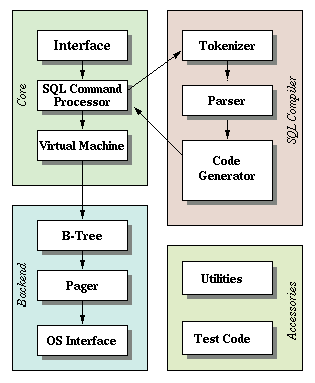Building a clone of sqlite from scratch in order to understand how does a database work.
https://cstack.github.io/db_tutorial/
How Does a Database Work?
- What format is data saved in? (in memory and on disk)
- When does it move from memory to disk?
- Why can there only be one primary key per table?
- How does rolling back a transaction work?
- How are indexes formatted?
- When and how does a full table scan happen?
- What format is a prepared statement saved in?
Tokenizer -> Parser -> Code Generator -> Virtual Machine -> B-Tree -> Pager -> OS Interface
A query goes through a chain of components in order to retrieve or modify data. The front-end consists of the:
- tokenizer
- parser
- code generator
The input to the front-end is a SQL query. the output is sqlite virtual machine bytecode (essentially a compiled program that can operate on the database).
The back-end consists of the:
- virtual machine
- B-tree
- pager
- os interface
The virtual machine takes bytecode generated by the front-end as instructions. It can then perform operations on one or more tables or indexes, each of which is stored in a data structure called a B-tree. The VM is essentially a big switch statement on the type of bytecode instruction.
Each B-tree consists of many nodes. Each node is one page in length. The B-tree can retrieve a page from disk or save it back to disk by issuing commands to the pager.
The pager receives commands to read or write pages of data. It is responsible for reading/writing at appropriate offsets in the database file. It also keeps a cache of recently-accessed pages in memory, and determines when those pages need to be written back to disk.
The os interface is the layer that differs depending on which operating system sqlite was compiled for. In this tutorial, I’m not going to support multiple platforms.
SQL compiler parses a string and output an internal representation called bytecode.
This bytecode is passed to the virtual machine, which executes it.\
Breaking things into two steps like this has a couple advantages: \
- Reduces the complexity of each part (e.g. virtual machine does not worry about syntax errors)
- Allows compiling common queries once and caching the bytecode for improved performance
The B-Tree is the data structure SQLite uses to represent both tables and indexes.
- Searching for a particular value is fast (logarithmic time)
- Inserting / deleting a value you’ve already found is fast (constant-ish time to rebalance)
- Traversing a range of values is fast (unlike a hash map)
A B-Tree is different from a binary tree (the “B” probably stands for the inventor’s name, but could also stand for “balanced”).
Each node can have up to m children, where m is called the tree’s “order”. To keep the tree mostly balanced, we also say nodes have to have at least m/2 children (rounded up). \
Exception:
- Leaf nodes have 0 children
- The root node can have fewer than m children but must have at least 2
- If the root node is a leaf node (the only node), it still has 0 children
SQLite uses B-Tree to store indexes. To store tables, SQLites uses a variation called B+ Tree.
| B-tree | B+ tree | |
|---|---|---|
| Pronounced | “Bee Tree” | “Bee Plus Tree” |
| Used to store | Indexes | Tables |
| Internal nodes store keys | Yes | Yes |
| Internal nodes store values | Yes | No |
| Number of children per node | Less | More |
| Internal nodes vs. leaf nodes | Same structure | Different structure |
B+ Tree
| For an order-m tree… | Internal Node | Leaf Node |
|---|---|---|
| Stores | keys and pointers to children | keys and values |
| Number of keys | up to m-1 | as many as will fit |
| Number of pointers | number of keys + 1 | none |
| Number of values | none | number of keys |
| Key purpose | used for routing | paired with value |
| Stores values? | No | Yes |
https://cstack.github.io/db_tutorial/parts/part7.html
gem install bunlderSpecify dependencies in a Gemfile in project’s root.
source 'http://rubygems.org' gem 'rspec'
bundle install --path vendor/bundletests file “spec/main_spec.rb”
bundle exec rspecPart 4
if you failed “prints error message when table is full”, comment “free_table(table);” in do_meta_command method, uncomment it until fixing all bugs in the end.
